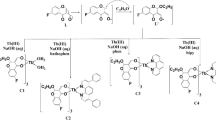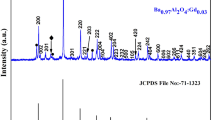Abstract
Laser-induced room temperature luminescence of air-equilibrated benzophenone/O-propylated p-tert-butylcalix-[4]arene solid powdered samples revealed the existence of a novel emission, in contrast with benzophenone/p-tert-butylcalix[4]arene complexes, where only benzophenone emits. This novel emission was identified as phosphorescence of 1-phenyl-1,2-propanedione, which is formed as the result of an hydrogen atom abstraction reaction of the triplet excited benzophenone from the propoxy substituents of the calixarene. Room temperature phosphorescence was obtained in air-equilibrated samples in all propylated hosts. The decay times of the benzophenone emission vary greatly with the degree of propylation, the shortest lifetimes being obtained in the tri- and tetrapropylated calixarenes. Triplet–triplet absorption of benzophenone was detected in all cases, and is the predominant absorption in the p-tert-butylcalix[4]arene case, where an endo-calix complex is formed. Benzophenone ketyl radical formation occurs with the O-propylated p-tert-butylcalix[4]arenes hosts, suggesting a different type of host/guest molecular arrangement. Diffuse reflectance laser flash photolysis and gas chromatography–mass spectrometry techniques provided complementary information, the former about transient species and the latter regarding the final products formed after light absorption. Product analysis and identification clearly show that the two main degradation photoproducts following laser excitation in the propylated substrates are 1-phenyl-1,2-propanedione and 2-hydroxybenzophenone, although several other minor photodegradation products were identified. A detailed mechanistic analysis is proposed. While the solution photochemistry of benzophenone is dominated by the hydrogen abstraction reaction from suitable hydrogen donors, in these solid powdered samples, the α-cleavage reaction also plays an important role. This finding occurs even with one single laser pulse which lasts only a few nanoseconds, and is apparently related to the fact that scattered radiation exists, due to multiple internal reflections possibly trapping light within non-absorbing microcrystals in the sample, and is detected until at least 20 µs after the laser pulse. This could explain how photoproducts thus formed could also be excited with only one laser pulse.
Similar content being viewed by others
References
A. M. Botelho do Rego and L. F. Vieira Ferreira, in Handbook of Surfaces and Interfaces of Materials, Vol. 2, ed. H. S. Nalwa, Academic Press, New York, 2001, ch. 7, pp. 275–313.
F. Wilkinson and G. P. Kelly, in Photochemistry on Solid Surfaces, ed. M. Anpo and T. Matsuara, Elsevier, Amsterdam, 1989, pp. 31–47
F. Wilkinson G. P. Kelly, in Handbook of Organic Photochemistry, Vol. 1, ed. J. C. Scaiano, CRC Press, Boca Raton, FL, 1989, ch. 12, pp. 293–314.
J. H. Hurtubise, Solid-matrix luminescence analysis: photophysics, physicochemical interactions and applications, Anal. Chim. Acta, 1997, 351, 1–22.
L. F. Vieira Ferreira, I. Ferreira Machado, A. S. Oliveira, M. R. Vieira Ferreira, J. P. Da Silva and J. C. Moreira, A diffuse reflectance comparative study of benzil inclusion within p-tert-butylcalix[n]arenes (n = 4, 6 and 8) and silicalite, J. Phys. Chem. B, 2002, 106, 12584–12593
L. F. Vieira Ferreira, M. R. Vieira Ferreira, A. S. Oliveira and J. C. Moreira, Potentialities of diffuse reflectance laser-induced techniques in solid phase: a comparative study of benzophenone inclusion within p-tert-butylcalixarenes, silicalite and microcrystalline cellulose, J. Photochem. Photobiol., A, 2002, 153, 11–18
L. F. Vieira Ferreira, M. R. Vieira Ferreira, A. S. Oliveira, T. J. F. Branco, J. V. Prata and J. C. Moreira, Diffuse reflectance studies of β-phenylpropiophenone and benzophenone inclusion complexes with calix[4], [6] and [8] arenes, Phys. Chem. Chem. Phys., 2002, 4, 204–210.
L. F. Vieira Ferreira, J. C. Netto-Ferreira, I. Khmelinskii, A. R. Garcia and S. M. B. Costa, Photochemistry on surfaces: matrix isolation mechanisms for study of interactions of benzophenone adsorbed on microcrystalline cellulose investigated by diffuse reflectance and luminescence techniques, Langmuir, 1995, 11, 231–236
L. F. Vieira Ferreira, M. R. Freixo, A. R. Garcia and F. Wilkinson, Photochemistry on surfaces: fluorescence quantum yield determination of dyes adsorbed on microcrystalline cellulose, J. Chem. Soc., Faraday Trans., 1992, 88, 15–22
L. F. Vieira Ferreira, A. R. Garcia, M. R. Freixo and S. M. B. Costa, Photochemistry on surfaces: the solvent-matrix effect on the swelling of cellulose. An emission and absorption study of adsorbed auramine-O, J. Chem. Soc., Faraday Trans., 1993, 89, 1937–1944.
J. P. Da Silva, L. F. Vieira Ferreira, A. M. Da Silva and A. S. Oliveira, A comparative study of the photophysics and photochemistry of 4-chlorophenol adsorbed on silicalite and b-cyclodextrin, J. Photochem. Photobiol., A, 2002, 151, 157–164
L. F. Vieira Ferreira, and A. S. Oliveira, J. C. Netto-Ferreira, in Fluorescence Microscopy and Fluorescent Probes 3, ed. A. Kotyc, Espero Publishing, Prague, 1999, pp. 199–208.
L. F. Vieira Ferreira, M. J. Lemos, M. J. Reis and A. M. Botelho do Rego, UV/Vis absorption and luminescence and X-ray photoelectron spectroscopic studies of rhodamine dyes adsorbed onto different pore size silicas, Langmuir, 2000, 16, 5673–5680.
N. J. Turro, Modern Molecular Photochemistry, Benjamin Cummings, Menlo Park, CA, 1978
N. J. Turro, A. Masayuki and I. R. Gould, The laser vs. the lamp. A novel laser-induced adiabatic reaction and luminescence of benzophenone, J. Am. Chem. Soc., 1982, 104, 856–860.
C. D. Gutshe, Calixarenes, Royal Society of Chemistry, Cambridge, 1989
I. Alam and C. D. Gutsche, Calixarenes. 24. Complexation by water soluble calixarenes, J. Org. Chem., 1990, 55, 4487–4489
C. D. Gutsche and I. Alam, Calixarenes. 23. The complexation and catalytic properties of water soluble calixarenes, Tetrahedron, 1988, 44, 4689–4694.
D. M. Rudkevich, Nanoscale molecular containers, Bull. Chem. Soc. Jpn., 2002, 75, 393.
C. D. Gutsche and M. Iqbal, p-tert-Butylcalix[4]arene, Org. Synth., 1990, 68, 234–237
K. Iwamoto, K. Araki and S. Shinkai, Conformations and structures of tetra–O-alkyl-p-tert-butylcalix-[4]arenes. How is the conformation of calix[4]arenes immobilized?, J. Org. Chem., 1991, 56, 4955–4962.
J. C. Netto-Ferreira and J. C. Scaiano, Photochemistry and photophysics from the excited states of diaryl ketyl radicals [1], Res. Chem. Intermed., 1989, 12, 187–201
M. Barra and J. C. Scaiano, Photoinduced transient phenomena in cyclodextrin solid complexes: photochemistry of aromatic ketones, Photochem. Photobiol., 1995, 62, 60–64.
W. C. McGimpsey and J. C. Scaiano, Chem. Phys. Lett., 1987, 138, 13
Y. Kajii, T. Suzuki, Y. Takatori, K. Shibuiya and K. Obi, Photodissociation of highly-excited triplet state of benzophenone studied by a time-resolved thermal lensing technique, Bull. Chem. Soc. Jpn., 1992, 65, 1349–1355.
F. Wilkinson and C. J. Willsher, Detection of triplet-triplet absorption in microcrystalline benzophenone by diffuse-reflectance laser flash photolysis, Chem. Phys. Lett., 1984, 104, 272–276.
M. B. Ledger and G. Porter, Primary photochemical processes in aromatic molecules. Part 15, J. Chem. Soc., Faraday Trans. 1, 1972, 68, 539–553
R. V. Bensasson and J. C. Gramain, Benzophenone triplet properties in acetonitrile and water, J. Chem. Soc., Faraday Trans. 1, 1980, 76, 1801–1810
S. B. Sharma, M. Mudaliar, B. S. M. Rao, H. Moahn and J. P. Mittal, Radiation chemical oxidation of benzaldehyde, acetophenone and benzo-phenone, J. Phys. Chem. A, 1997, 101, 8402–8408.
S. Monti, L. Flamigui, A. Martelli and P. Bortolus, Photochemistry of benzophenone-cyclodextrin inclusion complexes, J. Phys. Chem., 1988, 92, 4447–4451.
P. Suppan, Chemistry and Light, Royal Society of Chemistry, Cambridge, 1994
J. C. Scaiano, E. B. Abuin and L. C. Stuart, Photochemistry of benzophenone in micelles. Formation and decay of radical pairs, J. Am. Chem. Soc., 1982, 104, 5673–5679.
M. Barra and J. C. Scaiano, Diffuse reflectance laser-flash photolytic study of aromatic ketones within calixarene solid matrixes, Supramol. Chem., 1998, 10, 91–95.
Author information
Authors and Affiliations
Corresponding author
Rights and permissions
About this article
Cite this article
Ferreira, L.F.V., Ferreira, M.R.V., Da Silva, J.P. et al. Novel laser-induced luminescence resulting from benzophenone/O-propylated p-tert-butylcalix[4]arene complexes. A diffuse reflectance study. Photochem Photobiol Sci 2, 1002–1010 (2003). https://doi.org/10.1039/b306582k
Received:
Accepted:
Published:
Issue Date:
DOI: https://doi.org/10.1039/b306582k




